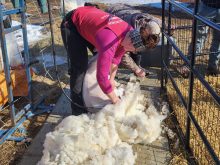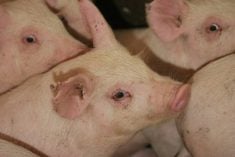OKOTOKS, Alta. – Adding value to a farm product can be fun but it also involves hard work and vision.
For beekeepers Cherie and Art Andrews, setting up a honey store on their 80 acre farm south of Okotoks means a list of chores every day. There is tending their 250 hives scattered on 10 farms from Okotoks to Strathmore, collecting honey, maintaining the farmyard for visitors and minding the store.
The Chinook Honey Co. store opened a year ago and six days a week sells honey off the farm as well as honey based lotions, candles, beeswax and novelties.
Read Also

Charges laid after cattle theft
Saskatchewan RCMP lay two charges against a man after six cattle went missing.
The Andrews started with two hives 10 years ago on an acreage near Calgary. Art originally came from a farm in Prince Edward Island while Cherie had grown up in the city but loved the rural lifestyle.
They were Canadian Airlines employees and fearing they might lose their jobs, they looked for sideline work. Cherie eventually was laid off as a dispatcher and Art joined Air Canada as a pilot.
They moved to their present location in 1999 and built the honey facility where Cherie works full time and Art is available part time.
“We’re small so we have to do this retail to make a go of this,” she said.
“It’s a lot of work and you have to be multi-talented. I have had to learn a lot of things.”
Cherie manages the store, cares for the bees, extracts honey, fills and labels bottles, makes candles and has been building shelves for an expansion within the store. In her spare time she is marketing honey and along with Art offers farm tours.
The hardest part was learning what to charge the tourists. With business advice from Alberta Agriculture, they learned to place a value on their time and work.
“I found it sometimes hard to do that but if you think about your time that you are spending doing it, you should be paid,” she said.
“And, people will pay.”
The shop is doubling in size this summer. It includes an education centre with an enclosed glass box showing the life stages of a bee, as well as preserved samples of a queen, drone and worker. There is a glass-framed hive to show the colony at work with bees caring for the queen and crawling through a glass tube to fly outdoors to collect pollen.
Advice has come from other beekeepers and earlier this year Cherie earned a scholarship through Alberta Agriculture to tour Quebec value-added honey farms and learn more about the retail side.
The hives produce up to 9,000 kilograms of honey per year. All the processing is done on the farm and sold through the store, at farmers’ markets or special orders to bakeries and chefs who are part of Dine Alberta, which encourages chefs to use locally produced food.
The Andrews’ season starts in March when they start feeding sugar water to the overwintered bees. The hives are wrapped with an insulated plastic and by creating their own heat, the bees stay warm throughout winter.
New bees arrive in April. They are generally imported from Australia and arrive in special boxes containing about 1.8 kg of bees.
Throughout the spring they analyze which hives appear strongest and then take three frames from the hive box and put them in different box with a new queen. Importing new queens is cheaper than buying entire new colonies.
The Andrews’ bees were hit hard with mites last year and about 25 percent died, so hives must be rebuilt. This takes time because the bees have a social structure. Groups are rarely mixed and a new queen is introduced slowly so the bees accept her. There is only one queen per hive and it can live up to five years. At the peak of summer it may lay 1,000 eggs each day.
Summertime feed comes from alfalfa fields. Alfalfa fed bees produce a light coloured honey with a mild flavour. Clover, dandelions and buckwheat also produce good honey.
Honey is collected and processed in late August or early September. It is not filtered or pasteurized.
Few beekeepers are moving toward retail.
“We have such a discrepancy in our industry between small commercial and large commercial,” she said.
Many of the large operations are multi-generational with beekeeping part of the culture of the family. Large producers have thousands of hives that keep them occupied year round. Most prefer selling into the wholesale market.
However, the price of honey has dropped in the last year and apiarists are facing competition from Chinese and Venezuelan honey that can be sold here as Canada No. 1 or blended with domestic product. This foreign honey tends to be much cheaper because labour costs are lower.
For Art and Cherie, retail sales made sense because they can get more consistent prices from fewer hives.
The Calgary trading area offers more than a million potential customers. Many are repeats looking for local, naturally produced foods and are willing to pay extra for quality.
“This is an excellent location. We’ve gone farther than I expected,” said Cherie.
The ideas for improvements are endless and for the Andrews, the main question is deciding how big they want to grow. They must decide how many more hives they can manage, whether they want a bigger store or more advanced honey processing and whether to offer a larger line of products or hire employees.
“I have to decide next where I want to direct my energy,” said Cherie.

















